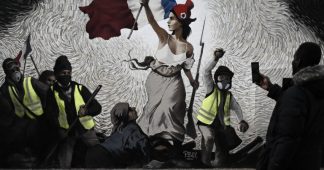Toronto International Film Festival 2019: Part 6
By David Walsh
2 October 2019
This is the sixth and final part in a series of articles devoted to the recent 2019 Toronto International Film Festival (September 5-15). The first part was posted September 11, the second on September 18, the third on September 20, the fourth on September 24 and the fifth on September 28.
In the course of attending film festivals for more than a quarter-century, we have encountered numerous films, fiction and non-fiction, set in the working-class suburbs (banlieues) surrounding Paris. One of the first such works, La Haine (“Hate,” directed by Mathieu Kassovitz) screened at the 1995 Toronto film festival.
These suburbs, with their run-down housing projects and generally wretched surroundings, are often home to the families of immigrants or descendants of immigrants from France’s former colonial empire in North and West Africa. The unemployment rate there for young people in particular is exceptionally high.
Major rioting occurred in these seething, impoverished neighborhoods and in many French cities and towns in late 2005 after two youth died while fleeing police in Clichy-sous-Bois in Paris’ northeastern suburbs.
Films dealing with these areas and conditions have varied in tone—angry, resigned, despondent, cynical. But it seems more than a coincidence that in the year of the “yellow vests” protests in France and an overall resurgence of the class struggle, the Toronto film festival screened one of the first works, Les Misérables (“The Wretched,” Ladj Ly), that depicts the oppressed youth organizing themselves to resist their conditions. The limitations of their semi-spontaneous revolt are undeniable and, to a certain extent, inevitable, but images of the tormented turning the tables on their tormentors must have an objective significance.
The association of French-Malian director Ly’s drama with Victor Hugo’s famed novel Les Misérables (1862) goes beyond the poverty-stricken circumstances of the characters represented in both works. Hugo located part of his sprawling book in Montfermeil, now a commune in the eastern suburbs of Paris and the site of significant protest and unrest in 2005. Ly grew up in the area and it is the setting for his new film. The director has spent years bringing attention to the conditions there.
The film opens amid the huge, exuberant celebrations in the French capital following the victory of the country’s national team in the 2018 World Cup. A group of kids from Montfermeil participates along with everyone else in the madly flag-waving crowd, and later joins in the singing of the La Marseillaise. As a character says later, “France is happy.” Ly’s images of a euphoric, supposedly unified nation, imply a different reality: that France is deeply polarized and that the youth have little in common with those manipulating or benefiting from the patriotic outburst.
Ly organizes the drama proper along somewhat familiar lines. It is the first day on the job for Stéphane (Damien Bonnard), a policeman transferred to Paris from a small town who tries to conduct himself “by the book.” He is teamed up with plainclothes partners Chris (Alexis Manenti) and Gwada (Djebril Zonga), the son of African immigrants, who have long ago given in to cynicism and the dishing out of casual, arbitrary violence. They justify their behavior by referring to “the brutality of our world.”
Members of a special anti-crime unit, Chris and Gwada, with Stéphane in reluctant tow, spend the day harassing the local residents and youth in particular, checking in with informers, pursuing petty criminals and petty crime, inappropriately frisking teenage girls and generally throwing their weight around. They regard the residents with contempt, as so much human refuse, and are hated in return.
Meanwhile, one of the local kids, Issa (Issa Perica), steals a lion cub from a traveling circus. The circus owner and his clan storm the headquarters of the project’s self-appointed and thoroughly corrupt “mayor,” brandishing weapons and threatening to wreak havoc unless the valuable animal is returned. The three cops, in an effort to calm the situation, launch their own search.
Foolishly, Issa advertises his theft on social media and is eventually tracked down, although the young lion has escaped his custody by this point. When Issa’s angry friends protest his arrest, the policemen panic. Gwada ends up shooting the young boy in the face with his flash-ball (the same police weapon that caused “yellow vests” organizer Jérôme Rodrigues to lose an eye and a photographer taking photos of the protests to lose three fingers).
Buzz (Al-Hassan Ly), a neighborhood kid who flies a small drone, mostly to spy on girls, captures the incident on video. The cops frantically attempt to cover their tracks by getting hold of the footage, by any means necessary. At one point, “cowboy” Chris screams, “I am the law!”
By the end of the day, things appear to have settled down. The cops have the incriminating video in their hands. The lion cub has been restored. Issa has survived his painful and potentially fatal or debilitating injury. The sun sets on the grimy neighborhood, and the three cops return to theirs.
But the director, and the local kids, have a surprise in store. The latter prepare an ambush, not only of the police, but of the black “mayor” and the local drug lord … A pitched battle ensues.
Les Misérables is convincingly and effectively done. Ly knows the area, he knows the youth and their bleak lives. He understands the elementary, undeniable truth that when water is heated to a certain temperature, it boils.
The policeman’s eye-view raises certain questions. The director tends to see the police as merely “untrained” or “unprepared.” In fact, as an indispensable arm of the capitalist state, they are doing in Les Bosquets and elsewhere precisely what they are hired and mobilized to do—intimidate, repress, terrorize.
Ly deserves credit for his commitment and determination to social truth.
The film ends with the famous lines from Hugo’s Les Misérables: “There are no such things as bad plants or bad men. There are only bad cultivators.”
Made in Bangladesh
Rubaiyat Hossain’s Made in Bangladesh is interesting for one reason and one reason only: it provides a glimpse of the lives of textile workers in Dhaka, Bangladesh and of the city itself.
The textile industry in Bangladesh is massive. In 2016, the country was second in the world, after China, in producing ready-made garments. It is also the globe’s second-largest exporter of what are known as “fast fashion brands.” Some 3.5 million workers toil in nearly 5,000 garment factories in Bangladesh. The industry generates 80 percent of the country’s total export revenue. Some 85 percent of the grossly underpaid and super-exploited workers are women.
Miserable and unsafe conditions prevail, as the Bangladesh factories press workers to meet deadlines set by ordering companies. Many are forced to work 12-14 hours a day, seven days a week for far less than a living wage. Fires periodically kill dozens and dozens of workers. In December 2010, for example, 30 people died and another 200 were seriously injured in a fire at the That’s It Sportswear garment factory on the outskirts of Dhaka. In November 2012, 117 people were killed and 200 injured at the Tazreen Fashion factory in the capital city.
Horrifyingly, in April 2013, more than 1,100 textile workers died and 2,400 more were injured when Rana Plaza, an eight-story, substandard building that housed five garment factories in Savar, just outside Dhaka, collapsed.
In Hossain’s film, Shimu (Rikita Nandini Shimu), 23, originally from a small village, works in one of Dhaka’s thousands of sweatshops. Her husband is unemployed.
After a fire kills a co-worker, Shimu is approached by a union advocate who instructs her in women workers’ rights. In her effort to organize a union, Shimu comes up against management, who alternately bully or try to bribe her, the anxieties of fellow workers desperate to keep their jobs and, ultimately, her husband’s backwardness.
Made in Bangladesh alternates between realistic bits of life and the predictable, formulaic sort of “drama” one would expect to emerge from one of the many NGOs that operate in such areas.
Shimu and the other young women in the film are lively, foul-mouthed and tough. These are no shrinking violets. In this regard, Hossain’s film hits the right note. The proletarianization of wide layers of the rural, female population in Bangladesh has vast and historic implications, and not middle-class feminist ones.
The picture of life Made in Bangladesh offers, including images of unspeakable poverty in Dhaka’s garbage-littered streets and alleys, flies directly in the face of the suggestion that this can all be resolved if only the women sign up for a trade union ! It could hardly be clearer, simply on the basis of the film’s own imagery, that only the revolutionizing of the society from top to bottom will bring about the necessary changes.
Mariam, from Kazakhstan
Another picture of devastating poverty and perhaps even greater cultural deprivation arrives in the form of Mariamfrom Kazakhstan, the former Soviet republic. The director, Sharipa Urazbayeva, came across Meruert Sabbusinova and her story while working for a local television channel. Remarkably, she ended up casting Sabbusinova to play herself.
Mariam (the character’s name in the film) is a woman living in desolate, rural Kazakhstan, with several children, whose husband disappears one day. Because there is no corpse, proof of her husband’s death, she is ineligible for government assistance. She has no money and no means of support. A policeman, who used to be interested in her, helps her find a way to the benefits. He seems intent on moving into her life. She begins collecting money from the government that keeps her family afloat.
Suddenly, and inconveniently, her ill-mannered, taciturn husband re-appears, without any explanation as to where he’s been, and apparently expects their life to resume from the point when he took off. Mariam hides him, so she can continue receiving the state assistance and the cop’s solicitude. She tells her husband frankly: “Now you are dead.” Mariam ends there.
The film is limited. Is the director merely admiring of Mariam’s ingenuity and determination or, more insightfully, indicting a wretched, poverty-stricken condition that requires an individual to demonstrate ingenuity and determination simply to stay alive? It’s not clear.
Rocks and August
In Rocks, directed by British filmmaker Sarah Gavron (This Little Life, Brick Lane, Suffragette), a schoolgirl hides the fact her mother has disappeared, out of fear she will be separated from her younger brother.
When a neighbor eventually alerts the authorities, Rocks (Bukky Bakray) turns to her best friend. They subsequently quarrel. “I don’t need you.” She skips school with a new girl and ends up stealing money from her. Eventually, another friend calls social services. “You can’t keep going on by yourself.” Rocks is placed in foster care, as is her brother.
Gavron says the film is “about the resilience, joy, and spirit of girlhood.” Is girlhood so joyful in the world as it is? Why does the director feel obliged to think it is? A political agenda hovers over this film.
There are some moments where the group of working-class girls seem genuine and honest. At other times, the film is a bit dull and takes on the character of a middle-class morality tale, almost a cinematic finger-wagging.
August is a Cuban film, directed by Armando Capó, about the 1994 balseros [rafter] crisis. Following the collapse of the Soviet Union, economic conditions worsened sharply in Cuba and thousands attempted to emigrate to the Bahamas, the Cayman Islands and, above all, the US.
The film follows Carlos, a teenager, and a couple of his friends as they attempt to grow up under the difficult conditions in Gibara, a rural coastal town. Power outages are common. The conditions are spartan. Carlos and the others watch people leaving in frail boats. The girl he has a crush on, Elena, departs. So too does his father. Carlos tries as well, but events or his own uncertainty betray him. A mural reads, “Cuba, happy like the sun.” His mother, finally, demands to know, “What are you going to do after the summer break?” The question obviously has a more long-term, metaphorical, perhaps even national significance. Carlos just shrugs.
August is pleasant enough, but rather bland, considering the events and the circumstances. Something more probing and challenging than a non-committal shrug seems called for.
Desert One
We should write further on Barbara Kopple’s Desert One, a film about the US military’s effort in April 1979 to free American embassy staff captured during the 1979 Iranian revolution, if and when it is released.
It is a deplorable work, which, while making minor gestures in the direction of Iranian suffering under the US-backed Shah’s regime, espouses nauseating pro-military and patriotic sentiments. In particular, it is a cinematic ode to former President Jimmy Carter and US Special Forces.
Kopple came to prominence with Harlan County, USA (1976), a documentary film focused on the Brookside Mine strike of 1973 in Harlan County, Kentucky, which pitted 180 coal miners and their families against the giant Duke Power Company (today Duke Energy). She later directed American Dream (1990), about the Hormel Food strike of 1985-86, and Shut Up & Sing! (2006), on the Dixie Chicks and their criticisms of George W. Bush and the Iraq war.
Kopple’s Desert One presents Operation Eagle Claw, the Carter administration’s plan to rescue the 52 US embassy staff, many of them no doubt CIA agents and spies complicit in the crimes of the Shah’s torture regime, as noble and heroic. The press notes begin excitedly: “It has been called ‘the most audacious, difficult, complicated, rescue mission ever attempted.’ Desert One uniquely blends emotion and bravado to tell the incredible tale of America’s secret mission to free the hostages of the 1979 Iranian revolution.”
Much of the film simply provides a platform for Carter administration officials and former special forces officers and soldiers to wax nostalgic about the operation, which ended in a complete fiasco in the Iranian desert.
Kopple, in her director’s statement, writes: “There was something special about these ‘special operations’ warriors I came to know making Desert One. I was touched to be able to get to know another side of them I had never seen, and it changed me. They got real and surprisingly emotional with me. I will never forget the very personal conversations we had as they sat down to interview, telling me their own piece of a bigger story that clearly matters to them.
“I also experienced one of the most precious moments of my career on this film, sitting down to interview President Jimmy Carter.”
Kopple’s interviewees include, along with Carter, former Vice President Walter Mondale; former Secretary of Defense Robert Gates; Ted Koppel, the longtime anchor on ABC’s “Nightline” (as the WSWS once characterized him, an “insufferable statesman of the airwaves” who was “little more than a conduit for US government and ruling elite propaganda”); Maj. James Q. Roberts, who, according to the film’s press notes, spent “three decades working in the office of the Secretary of Defense for Special Operations/Low-Intensity Conflict which oversees Special Forces command,” and other assorted reprobates and professional killers.
A special mention must be made of the appearance in Kopple’s film by Maj. William G. Boykin, the Christian Right zealot. Boykin made a foul name for himself in 2003 when, as deputy undersecretary of defense for intelligence, he repeatedly asserted that the Bush administration’s “war on terror” was a religious war between Christianity and Islam, while making it clear that he himself answered only to God. There is certainly “something special” about him.
This is the company the former radical, Kopple, now keeps. Another American petty bourgeois returned to the fold.
Published at https://www.wsws.org/en/articles/2019/10/02/tff6-o02.html











